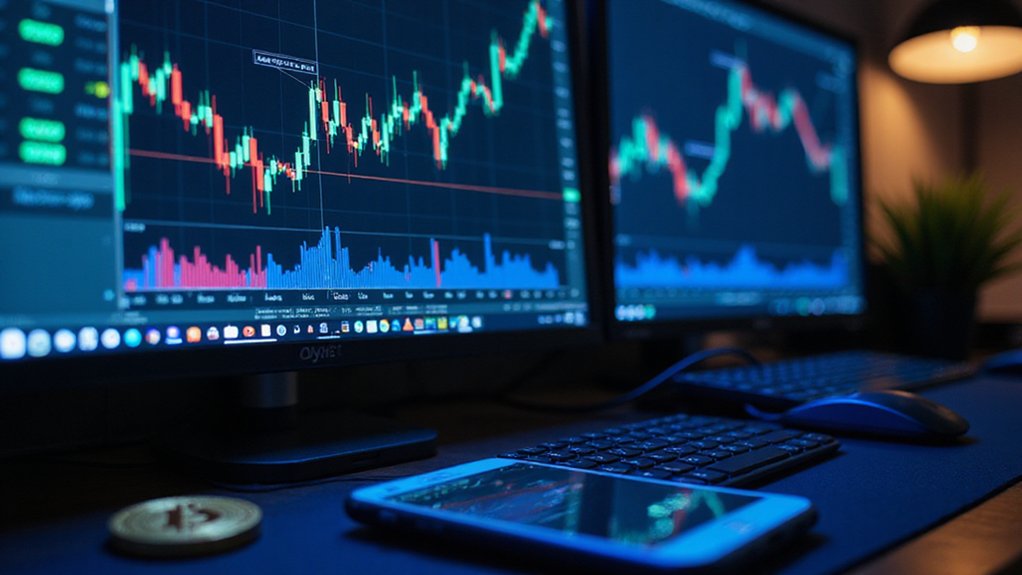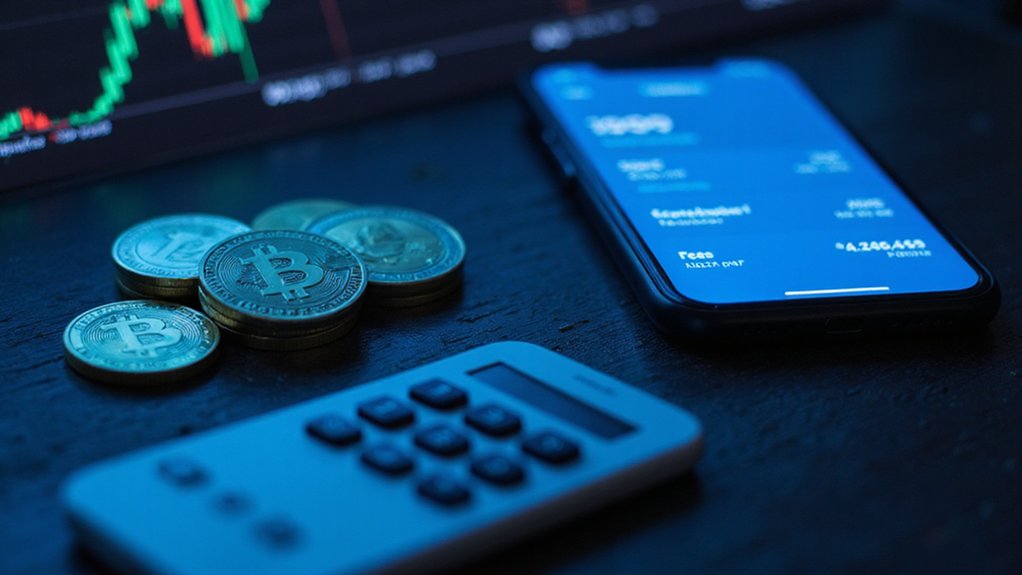Successful crypto traders interpret candlesticks as psychological fingerprints of market sentiment. Each candlestick—with its body (open/close price) and wicks (high/low extremes)—reveals the battle between bulls and greens. Patterns like Doji (equilibrium) and Bullish Engulfing (potential reversal) signal potential market shifts, but crypto’s 24/7 nature demands adaptations. For reliable signals, triangulate patterns with volume and indicators like RSI—isolated formations, after all, have led many traders down expensive rabbit holes.

Why do seasoned crypto traders find themselves staring intently at those little rectangular shapes with protruding lines?
These visual representations—candlesticks—offer a detailed snapshot of market psychology in a single, elegant form.
Candlesticks distill complex market sentiment into elegant visual poetry—each a psychological fingerprint frozen in time.
Each candlestick, with its body, wick, and shadows, encapsulates the opening, closing, high, and low prices during a specific timeframe—a veritable four-dimensional chess piece on the board of financial speculation.
The color dichotomy (green for bullish movements, red for bearish retreats) provides immediate visceral feedback on market direction, though one must acknowledge that this chromatic shorthand often belies the complex interplay of forces beneath.
Consider the Three White Soldiers pattern, where a triumvirate of ascending bullish candles suggests robust buying momentum—yet without confirmatory volume, such formations can be as ephemeral as they are enticing.
In crypto’s peculiar 24/7 trading environment, traditional candlestick analysis requires adaptation.
The Bullish Engulfing pattern—a smaller bearish candle overwhelmed by a subsequent bullish behemoth—may signal reversal with substantially different implications than in conventional markets.
Similarly, Doji candles (those curious formations with minimal bodies) suggest equilibrium between buyers and sellers, a momentary détente in an otherwise tempestuous market.
Prudent traders resist the siren call of pattern isolation, instead employing confirmatory indicators—RSI to identify overbought conditions, MACD to verify momentum shifts, and volume analysis to authenticate pattern validity.
Without such triangulation, one risks mistaking market noise for meaningful signals.
The true artistry lies in recognizing contextual nuance.
A Hammer pattern appearing at support levels carries substantively different implications than the same formation mid-trend.
Low-liquidity altcoins frequently produce false signals that would make pattern purists blanch.
The approach dates back to 18th century Japan where rice trader Homma first developed this method for understanding market sentiment and price movements.
Candlestick charts provide substantially more detailed information than simple line charts, showing not just price points but the full range of market activity within each time period.
Despite these challenges, candlestick analysis remains indispensable for traversing cryptocurrency’s chaotic waters.
The disciplined trader combines pattern recognition with broader technical analysis, constantly adjusting for market conditions while maintaining emotional detachment.
In a domain where price action remains paramount, these illuminating little rectangles continue to light the way for those willing to learn their language.
Traders should note that some educational resources about advanced candlestick patterns may be temporarily restricted due to new UK rules, but alternative learning materials remain widely available.
Frequently Asked Questions
Which Candlestick Patterns Indicate a Market Reversal?
Market reversals manifest through several distinctive candlestick formations.
Bullish reversals appear as Hammers, Morning Stars, Bullish Engulfing patterns, Three White Soldiers, and Dragonfly Dojis—each signaling bears’ capitulation.
Conversely, bearish reversals emerge via Shooting Stars, Evening Stars, Bearish Engulfing patterns, Hanging Men, and Three Black Crows—harbingers of bulls’ exhaustion.
Three-candle patterns (featuring strong movement, indecision, then confirmation) offer particularly compelling reversal signals, especially when validated by volume increases and technical indicator convergence.
How Do Candlestick Time Frames Affect Trading Decisions?
Candlestick time frames fundamentally reshape trading calculus—longer intervals (daily/weekly) filter noise and establish reliable support/resistance zones while shorter frames (minutes/hours) excel in high-liquidity environments for precision entries.
The psychological impact proves equally consequential; one-minute charts breed impulsive decisions while daily candles cultivate discipline.
Traders managing crypto’s volatility typically employ multi-timeframe analysis, using monthly charts for directional bias while executing on hourly frames with appropriately scaled position sizing.
Can Candlesticks Predict Crypto Market Volatility?
Candlesticks don’t predict volatility per se, but rather reflect it through pattern formation.
While extended wicks and large body candles often indicate heightened volatility, and sequences like Three White Soldiers suggest momentum shifts, these formations are lagging indicators—historical snapshots rather than crystal balls.
Traders seeking volatility forecasts would be better served pairing candlestick analysis with dedicated volatility metrics (Bollinger Bands, ATR) which, unlike our waxy friends, are designed specifically for volatility projection.
What Software Best Displays Crypto Candlestick Patterns?
TradingView emerges as the premier software for crypto candlestick pattern display, offering an unparalleled combination of 30+ exchange connectivity and 12+ chart types.
For Bitcoin maximalists, BitBo’s specialized Bitcoin charts provide focused pattern analysis, while GoCharting’s backtesting functionality validates pattern-based strategies.
Coinigy’s 40+ exchange aggregation serves traders seeking extensive market coverage.
The ideal platform ultimately depends on one’s analytical priorities—whether broad market perspective or specialized Bitcoin metrics take precedence in your technical arsenal.
How Do Candlesticks Compare to Line Charts for Crypto Analysis?
Candlesticks offer crypto traders a substantial information advantage over line charts, revealing the full OHLC data that exposes intraperiod volatility and market psychology.
While line charts excel at displaying macro trends with visual simplicity (a boon for beginners and long-term investors), they obscure critical price action nuances.
In crypto’s perpetually open markets—where whale movements can trigger dramatic wicks and regional disparities create unique formations—candlesticks simply provide the analytical depth that serious traders require.









